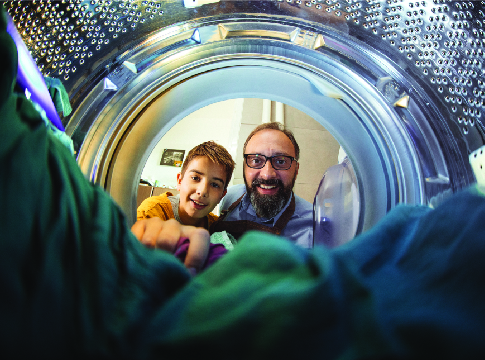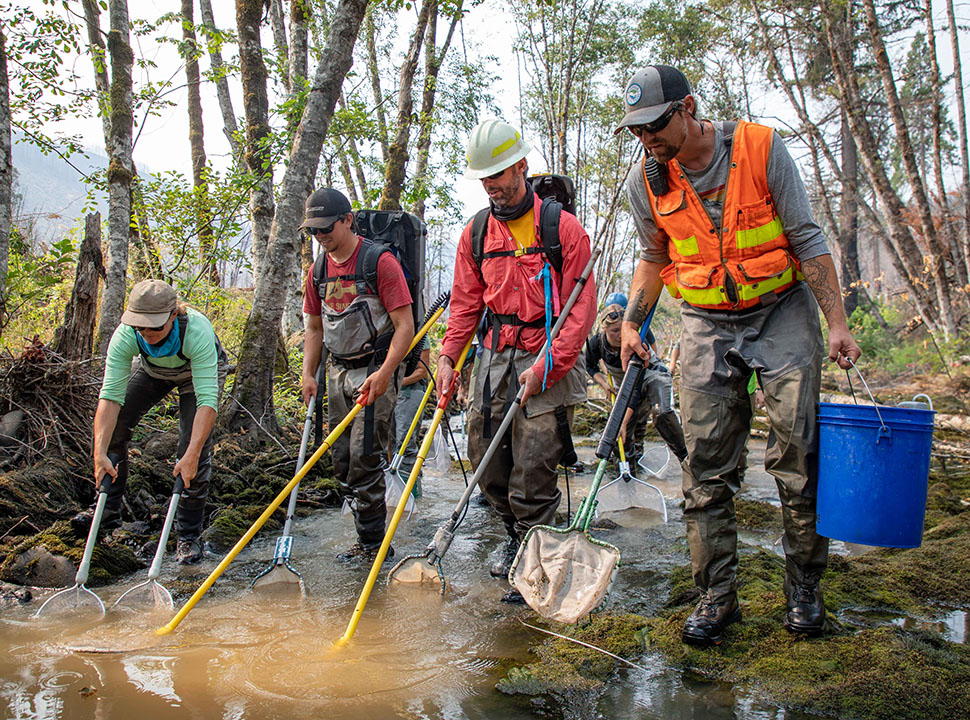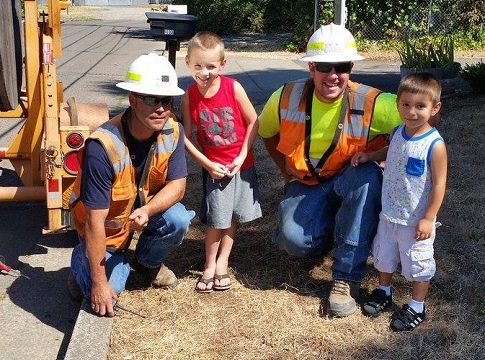EWEB decided to decommission the Leaburg Hydroelectric Project in January 2023 after an extensive Triple Bottom Line evaluation guided by expert consultants, with feedback from EWEB customers and community members, determined the facility is no longer economically viable and it would be irresponsible for EWEB to invest in future electricity generation at the facility.
Economic Considerations: Investing in the continued operation of the Leaburg Project would commit EWEB customers to overly-expensive electricity. Considering the costs to bring the project to regulatory compliance (an estimated $250M) plus the annual costs of operating the facility through 2080, EWEB's consultant estimated electricity would cost $117 per Megawatt hour, under ideal circumstances (water availability).
Instead of committing to such an irresponsible investment, EWEB Commissioners decided to decommission the project. EWEB will seek to purchase electricity from alternative sources on the energy market, where prices generally range from $30-$50/MW. Currently, EWEB's contract with the Bonneville Power Administration provides more than enough electricity at $33/MW and is how EWEB has been meeting demand since pausing generation at the Leaburg project.
Closing the Leaburg facility will lower EWEB’s liability to future risks, such as floods, earthquakes, changing river flows and regulations. Climate change has already impacted the regularity of snow packs and summer river flows and makes generation at run-of-the-river facilities inconsistent. Fisheries regulations will also become more stringent on hydropower generation. Less water will be available for generation, making investment in the future of the facility an increasingly irresponsible fiscal decision.
Environmental Considerations: Removing the Leaburg Dam, restoring Leaburg Reservoir to river form, and keeping water in the McKenzie River rather than diverting it into the power canal will have water quality benefits including reducing temperature exposure. Removing Leaburg Dam will benefit endangered salmon species and other fish.
Social Considerations: EWEB staff held more than 20 meetings to gather public input on the social impacts over the course of the decision process. Hundreds of customers in the McKenzie Valley emphasized the importance of Leaburg Reservoir as an important recreation site in the community. A majority of EWEB customers overall indicated their preference for a decision that would have the least impact on their electricity rates.
EWEB staff acknowledge the impact that decommissioning the reservoir will have on the community. Given the economic and environmental benefits to decommissioning, however, and the thousands of customers who prioritize EWEB's mandate to keep electricity rates as low as possible, the clear decision id to decommission the project.
To decommission the Leaburg Hydroelectric Project, EWEB will:
- Remove Leaburg Dam and restore Leaburg Reservoir to river form.
- Cooperate with transportation authorities to develop access to Leaburg Dam Road on the south side of the river.
- Configure the Leaburg Canal so it can convey tributary flows to the river.
- Work with the small number of neighbors who have certified water rights to get water from the Leaburg Canal to find alternate solutions, with particular focus on the Leaburg and McKenzie fish hatcheries.
- Perform a similar assessment of the Walterville Hydropower Project by 2030.
The Leaburg Dam will be removed for the following reasons:
- Federal Energy Regulatory Commission (FERC) Process: FERC’s default position and history maintain that the dam will be required to be removed because the primary purpose of the dam’s construction was for electricity generation, and permission to obstruct the river will not be extended for supplementary benefits such as recreation. FERC oversees all parts of the facility under a single licese to operate, and the dam, canal, penstocks, powerhouses, generators, transmission lines, etc. cannot be separated for individual consideration.
- Other Participant Demands: Government agencies and non-government organizations (NGOs) will call for the dam’s removal for associated benefits for fish and wildlife as part of the FERC-mandated process to negotiate the surrender of the license to operate and the impacts of decommissioning the facilities.
- EWEB’s Interest: It is not in EWEB’s interest to own, operate, maintain, and/or mitigate the risk of assets that don’t support our primary mission of delivering electricity and drinking water. The FERC-mandated process will explore any other options that meet EWEB’s needs, including sale, related to the future disposition of this asset.
As EWEB moves forward with decommissioning the project, further public input will be part of the FERC-mandated process. EWEB staff will advise our customers about project updates, including official opportunities and methods for public input. At this time, the decision is made and further deliberation of its impacts will be ineffective to reverse course.
Please watch this video to learn more about how EWEB's elected commissioners made their decision on January 6, 2023:
Frequently Asked Questions
Background

The Leaburg Hydroelectric Project was built in 1928. It generated electricity for 90 years by having a dam divert water into a canal to keep the water at a consistant elevation for 5 miles so that it could drop 80 feet down into a powerhouse to drive two turbines.
The canal has always leaked, but the discovery of increased seepage and internal erosion of the canal embankments in 2018 prompted the Federal Energy Regulatory Commission (FERC) to order EWEB to dewater the canal and cease power generation. In response to new information on earthquake safety risks, EWEB initiated a comprehensive assessment of the entire canal in late 2019 to better understand the level of investment that would be required to ensure long term safe and reliable operation. The canal has operated as a stormwater conveyance facility ever since, essentially collecting tributary waters from creeks on the north side of the valley and creating a path for that water to flow into the McKenzie River.
EWEB does not believe there is an imminent danger of a canal breach.
EWEB staff will continue to carefully monitor the structural performance of the Leaburg Canal, particularly in wet weather season and during storm events when tributary creek flows rise. EWEB staff are poised to identify and respond to any unexpected developments along the full length of the canal and will inform canal neighbors of any changes of concern. EWEB is already making the canal safer by implementing risk-reduction measures while pursuing a license surrender and project decommissioning.
EWEB staff is preparing a Leaburg Decommissioning Action Plan to define the next regulatory steps and project milestones to understand the environmental and social impacts, requirements, and opportunities for feedback as we move forward.
How the Leaburg Hydroelectric Project Worked:
Update: December 4, 2024: Decommissioning Consultant
Update: January 9, 2024: Leaburg Decommissioning Action Plan
Update: February 9, 2023: Presentation to the McKenzie Watershed Council
Update: December 6, 2022: Staff Recommends to Decommission Project
Update: November 21, 2022: Staff Recommendation Near
Update: August 17, 2022: Baseline Costs and Net Present Values
Update: May 17, 2022: Upriver Board Meeting
Update: April 11, 2022: Four Alternatives Selected for Study
Update: August 3, 2021: Preliminary TBL Study
Project Update: December 4, 2024: EWEB approves contract with firm behind Klamath River Renewal Program to help decommission Leaburg Hydroelectric Project.
Eugene Water & Electric Board (EWEB) Commissioners approved a ten-year, $18.5M contract with McMillen, Inc. to support efforts to decommission the Leaburg Hydroelectric Project at their Board Meeting on Tuesday, December 3, 2024.
McMillen rose to the top of a competitive public purchasing process to win the contract. The EWEB team leading the Leaburg Decommissioning Action Plan attributed McMillen’s high-scoring proposal to its team’s specific experience with decommissioning hydropower projects overseen by the Federal Energy Regulatory Commission (FERC).
“We are excited to bring on such a knowledgeable team to help us achieve our goal of decommissioning the Leaburg Hydroelectric Project,” said Karen Kelley, EWEB Chief Operations Officer. “With their experience on dozens of projects, and especially coming off of their success completing the Klamath decommissioning, we anticipate McMillen will find ways to assist us in the most cost effective, timely, and responsible way.”
McMillen served as the Owner’s Representative and Construction Manager on the Klamath River Restoration Project, which involved removing four dams on the Klamath River, restoring stretches of the river and collaborating between federal agencies, Oregon and California authorities, and several Indigenous Tribes.
In their role, McMillen provided direct oversight and facilitation of various project aspects, including design, permitting and regulatory process, agency and tribe coordination, stakeholder coordination, construction, dam demolition, and habitat restoration services on behalf of Klamath River Renewal Corporation (KRRC).
The nation’s largest-ever dam decommissioning, McMillen helped KRRC deliver on the challenge of keeping the $500M, fourteen-year project on budget and on-time.
“I personally am incredibly excited to put forth McMillen for this work. McMillen is a very well suited firm for this process. They have extensive decommissioning experience nationwide, including a primary role in the decommissioning of the Klamath dams, to great success,” Generation Manager Lisa Krentz said at Tuesday’s Board Meeting. “They're highly regarded throughout the industry. They have absolutely stellar recommendations from those who have worked with them. It is, again, a sizable contract and a long contract. But I couldn't be more pleased with the results.”
Decommissioning the Leaburg Hydroelectric Project will be a far smaller endeavor than the Klamath River Renewal Program.
EWEB Commissioners voted to decommission the project in 2023 following a triple bottom line evaluation that revealed the regulatory risk and costs to restore the project to service in accordance with required dam safety and design standards would far outweigh the project’s generation benefits.
With McMillen on board, EWEB will further investigate the impacts decommissioning the project would bring to the McKenzie River and the local community, including identifying information gaps. Key information gaps include how to remove sediment trapped behind the dam, how to restore the river through the project area and how its flow could change, and how EWEB can work with neighbors to reduce impacts to the local economy, recreation, and transportation networks.
McMillen will also help manage projects to reduce near-term risks the Leaburg Project may pose in its current state, navigate the FERC approval process, advance conceptual designs, and work with stakeholders to understand constraints and concerns.
EWEB is already working with Lane County Public Works and the engineering firm DOWL to resolve the problem of removing the bridge on top of Leaburg Dam. EWEB sent letters to 300 project neighbors in September advising about the issue and asking for information about the local terrain and traffic patterns.
EWEB plans to begin on-the-ground decommissioning work by 2032.
Project update: January 9, 2024: The Leaburg Decommissioning Action Plan
The Leaburg team has published their first draft of the Leaburg Decommissioning Action Plan - the LDAP.
The comprehensive plan outlines the essential actions, activities, and regulatory processes required for the decommissioning of the Leaburg Hydroelectric Project (Project).
The objective of the LDAP is to position EWEB to begin on-the-ground decommissioning activities by 2032.
Decommissioning entails the removal of the Leaburg Dam and the restoration of the McKenzie River to a free-flowing state within the Project area.
EWEB is already implementing risk-reduction measures to mitigate dam safety concerns with the Leaburg Canal. The LDAP outlines ways the utility will permanently modify portions of the Leaburg Canal to safely conveyserve as a safely and permanentconvey tributary flows ofcreeks to the McKenzie River.
The Federal Energy Regulatory Commission (FERC) oversees EWEB’s hydropower license. In its plan, EWEB maps out how it will navigate FERC processes to retire the Project.
The FERC process requires formal consultations with Indian Tribes, public agencies that manage natural resources and public health, as well as community members.
EWEB will also conduct extensive studies on decommissioning effects, such as how the hydrology of the river will change, water quality impacts, and impacts to endangered species, in order to develop strategies to mitigate negative impacts.
The Leaburg Dam is also a bridge connecting several residences, the Leaburg Fish Hatchery, a commercial blueberry farm, and timber plantations to Highway 126. EWEB and Lane County are already in contact to address how decommissioning will affect access to Leaburg Dam Road.
EWEB staff estimate it will take at least five years to assemble all the information required to apply to modify its license with FERC.
The full LDAP report is available here (click for PDF download of Leaburg Decommissioning Action Plan).
Project update: February 9, 2023: Presentation to McKenzie Watershed Council
Project update: December 6, 2022: Triple Bottom Line Assessment: Decommission Likely
At the December 6, 2022 EWEB Board Meeting, Commissioners indicated their support for the General Manager's proposal to decommission the facility.
General Manager Frank Lawson presented staff's recommendation to "permanently discontinue electricity generation at the Leaburg Hydroelectric Project," representing the findings of two years of in-depth analyses and an extensive public outreach process.
Internal erosion and seismically vulnerable soils among portions of the Leaburg Canal forced EWEB to shut down the hydroelectric project in 2018 and evaluate whether heavy investments into repairing the canal would be cost-effective, or if it is time for EWEB to decommission the 90-year-old project and cease generation.
The Leaburg project has historically generated about 4% of Eugene’s electricity needs. If EWEB were to continue generating, staff calculated the project would produce electricity at least three times more expensive than other carbon-free options.
EWEB will petition the Bonneville Power Administration (BPA), which already provides EWEB with about 80% of its energy, to replace the energy that would be lost by decommissioning Leaburg.
EWEB staff calculates the Levelized Cost of Energy to restore generation at Leaburg would produce electricity at $117/MWh. EWEB currently purchases electricity from the BPA at a much lower cost.
In addition to economic considerations, Lawson points to the benefits that decommissioning Leaburg would yield to McKenzie River water quality and fisheries, as well as alignment with the utility’s core mission and customer-owner priorities to reduce costs.
“Permanently discontinuing electricity generation at the Leaburg Hydroelectric Project will result in the removal of the dam, restoring the McKenzie River to unobstructed flow and eliminating the human-made Leaburg Lake behind the dam,” Lawson writes. “EWEB’s mission does not directly prioritize creating or managing recreational facilities, transportation assets, or other non-electricity or drinking water activities,” Lawson states.
To maintain access to the south side of the river, Lawson recommends developing alternative access via Goodpasture Bridge.
All of the alternatives EWEB has studied would require capital investments tallying more than $150 million and would result in substantial rate increases over time. The recommended direction is the lowest-cost alternative. EWEB forecasts that this alternative might require the utility to raise electricity rates by 9-10% between 2023 and 2040.
“As a publicly owned utility, it’s our responsibility to make the best decision for our customer-owners while also being good stewards of the McKenzie River,” said Generation Manager Lisa Krentz. “This has been a difficult decision that includes significant trade-offs and impacts to our community. We look forward to continuing to work with our customers and upriver neighbors as we plan for the next steps of this project.”
Commissioners responded approvingly to staff's recommendation. Board President John Brown commended the team's diligence in its investigation. He repeated concerns about what would happen to the McKenzie Salmon Hatchery should the project no longer deliver water, and wondered what would happen to Lloyd Knox Park. Krentz acknowledged those are chief concerns the team would further investigate.
Commissioner John Barofsky said he was initially in favor of a full return to service, but as he learned more about the costs and considerations through the Triple Bottom Line Assessment he understands this decision and would even support a full decommissioning of the entire Leaburg Canal, rather than leaving the canal as a stormwater conveyance facility. Commissioner Matt McRae shared Commissioner Barofsky's interest in pursuing full decommissioning if economically feasible and practical.
Commissioner Mindy Schlossberg also supported the pursuit of a full decommissioning, pointing to the maintenance costs and liability of managing the canal's stormwater conveyance function rather than returning the creeks to their historical trajectories to the river.
Vice President Sonya Carlson reiterated that the rate impacts implied by any action are a major concern for her, acknowledging that the recommended option - Alternative 4, Decommissioning with Stormwater Conveyance and No Bridge - is the lowest cost option. She also emphasized the uncertainties of hydropower generation with continued river flow variances tied to climate change and regulatory restraints tied to fish protection.
Next steps:
- Lawson will prepare a Record of Decision for the Board to endorse decommissioning the project while leaving open the possibility to pursue full decommissioning in the future. The Record of Decision will set in motion an implementation and action plan towards decommissioning.
- If approved, EWEB anticipates several years of planning and settlement negotiations prior to construction commencing likely in the 2030s.
- Work on near-term risk reduction measure projects will start as soon as next year but the potential work to remove the dam and lake will likely not begin for 10 years or more.
- EWEB will continue to work with the community to learn how decommissioning the project would impact local water access, recreational opportunities, fisheries, and community economics.
Read the General Manager's Recommendation and the supplemental materials of the Triple Bottom Line Assessment: Goal #3(a): General Manager’s Recommendation - Leaburg Canal TBL & Strategic Assessment Final Findings
Watch the Board Leaburg discussion on EWEB's YouTube Channel:
Frequently Asked Questions about the Implications of Decommissioning Leaburg
- What does this recommendation mean for the Leaburg Project?
Dam Removal: This direction includes removing the Leaburg Dam, restoring the human-made Leaburg Lake to an unobstructed river, and building a road to connect properties that have used the dam as a bridge to the Goodpasture Bridge a few miles upstream.
Canal Repairs: EWEB would reinforce the Leaburg Canal to act as a stormwater conveyance facility, taking the tributary creeks that flow into the canal back to the McKenzie River. EWEB would modify sections of the canal to reconnect certain creeks directly to the river.
- Without the dam, will flooding be an issue?
The Leaburg Dam is a run-of-the-river facility, meaning it doesn’t play a role in reducing the impact of floods. The dam serves to direct water into the canal, rather than impounding water to store it for hydropower generation. When in operation, the dam would divert only a maximum of 2,500 cubic feet per second (cfs) of water into the canal and the rest of the McKenzie River would flow through the dam’s rollgates. Because the Leaburg Project is run-of-the-river, its generation potential is directly influenced by water availability – a further risk consideration as climate change threatens to reduce summer flows and therefore would likely reduce the amount of energy the project could produce.
- When will construction begin?
If approved, we anticipate several years of planning and settlement negotiations prior to any construction related to decommissioning. Major decommissioning work is not anticipated to commence until the beginning of the 2030s, at the earliest. Work on near-term risk reduction measure projects will start as soon as next year (i.e. canal plugs for directing stormwater and an outfall gate at Johnson Creek), but the work to remove the dam and lake will likely not begin for 10 years or more.
- How will this decision impact customer electricity rates?
We estimate the costs to carry out this decision would require EWEB to raise electric rates by 9-10% between 2023 and 2040.
- What about Irrigators and properties with water access?
EWEB will work to mitigate water rights and water access issues where legally obligated and facilitate water access where possible, specifically for fish hatcheries.
- How did EWEB communicate with the public about this decision?
We’ve held a dozen meetings with the Eugene and upriver communities this year and have presented at community meetings like the Springfield Lions, the Santa Clara Neighborhood Association, and the Eugene Chamber of Commerce. We’ve also reached out to 23 other neighborhood associations, worked with local media outlets to cover the project, and communicated the project to all customers on the September bill message. We received over 420 responses to a public comment form that was open from June through October and have compiled thousands of comments as part of assessing the social impacts of the Triple Bottom Line Assessment.
Update: November 21, 2022: GM to Make Recommendation at Dec. 6 Board Meeting
EWEB’s publicly-elected Commissioners met with the Leaburg Hydroelectric Project Strategic Evaluation Team for a Work Session on October 25. Their goal was to find alignment on how they would prioritize the impacts of each of the four alternatives EWEB has proposed for the future of the Leaburg Project: full decommission, partial decommission, full return-to-service, or a partial return-to-service.
Prior to their three-and-a-half-hour conversation, Commissioners evaluated the alternatives based on a triple bottom line (TBL) assessment of the economic, environmental, and social impacts.
Their TBL exercise had two parts: EWEB staff have assigned a positive or negative score to each evaluated impact for each alternative based on interviews with our subject matter experts and public input.

To read a thorough explanation of how EWEB and our consultants assigned these scores, please download the full memo to the Board and go to “Attribute Scoring Approach” on page 13.
As a group average, Commissioners placed:
- 32% of the weight of the decision on the Economic Impacts,
- 28% on the Environmental Impacts, and
- 40% of the weight on the Social Impacts.
This weighting applied to the positive and negative scoring above yields Alternative 4: Partial Decommission (SWC) with the highest (least negative) score:

Staff also provided a scoring mechanism that reduces the impacts considered to the top three in each category to simplify the decision. When taking the scores for the top 3 impacts for each Commissioner, their average preference remains Alternative 4:

Despite these results, Commissioners emphasized that the TBL scoring tool won’t be the determining factor for their decision but instead an exercise to help them measure the quantitative and qualitative tradeoffs their decision implies.
At the Work Session, staff presented these results to Commissioners, noting the similarities and differences in Commissioners’ weighting priorities to guide their conversation:
- Common/Unique “Weighting” by Commissioners: All Commissioners provided significant TBL weight to the following considerations:
- Economic – Project Costs/Rate Impacts, Financing & Bond Impacts
- Environmental – Water Quality, Aquatic Resources, Carbon Footprint
- Social – Public Safety
- Wider discrepancies in weighting occurred in the following areas, potentially warranting further discussion:
- Economic – Economic Risk (Power Prices, Licensing, Construction, etc.)
- Environmental – Terrestrial/Avian Species, Wetlands
- Social – Local Economic Activity, Fish Hatcheries, Recreation
- (Note, most variance between Commissioner weighting occurred in the Social attributes/issues.)
Throughout the Work Session, Commissioners asked staff for further context on many of the impacts, each carefully evaluating tradeoffs from the varieties of perspectives of their constituents. (Watch a recording of their discussion on EWEB’s YouTube Channel).
The discussion did not seem to lead Commissioners closer to choosing an alternative, and by the end of the evening, they decided to postpone their decision for at least another month, with President Brown saying “I’ve always believed it’s better to be late than wrong.”
Staff will present additional answers to their detailed questions at the next Board Meeting on December 6.
General Manager Frank Lawson will also propose an official recommendation for a decision representing staff expertise.
Commissioners will have time over the holidays to consider the staff recommendation, with the current plan to reconvene at the start of the new year for their directional decision.
August 2022: Project Alternatives Baseline Cost Estimates and Net Present Values
On Tuesday, August 2, at 6:30 p.m., the Leaburg Project team presented the latest information (click to download their memo) to EWEB's elected Commissioners.
The Board Meeting (Video Recording) included updated cost estimates for each of the four proposed alternative configurations of the Leaburg Project, as well as the net present value (NPV - the difference between future costs and incomes) of each based on three varying projections of future electricity prices and upfront capital costs.
BASELINE COST ESTIMATES
The team worked with engineering consultants to calculate the costs of carrying out the proposed configurations for each alternative, including construction, construction management, licensing and permitting, site restoration, and many other costs. The cost estimates include a contingency for going over by 50% or coming in up to 30% under budget, as recommended by the American Association of Cost Engineering due to the project being in the “study or feasibility” phase.

Given the project’s early stages and the uncertainties of future costs, the cost estimates are as follows:

The work required to bring the project safely to a decommissioned or operational state involves significant upfront capital costs. As a publicly owned utility, expenses are largely funded through rate increases to EWEB’s customer-owners. However, EWEB will look for federal, state, and other grants to help with the costs of any alternative. The team has proposed an extended project timeline to attenuate the impacts of the potential rate increases:


Regardless of the alternative, EWEB would have to increase electricity rates to finance the required capital spending. Due to the complex calculations and pending decisions on other projects that would affect EWEB’s borrowing power, the Finance department is still calculating the potential rate increases each alternative would entail and will present that information to commissioners in October.
NET PRESENT VALUES
The net present value (NPV) for each alternative is substantially negative. Even when accounting for future incomes from electricity generated in the Return to Service alternatives, and including the optimistic projection of higher-than-anticipated market electricity rate and lower-than-expected capital construction cost, losses of over $130M are anticipated:

The Project Team worked with EWEB’s Generation, Power Planning, and Finance departments to calculate the costs and incomes for each alternative. Calculation inputs consider initial build costs, operation and maintenance, generation potential based on varying river flows, generation revenue based on varying power market prices, and incomes from Renewable Energy Credit and carbon markets that provide financial benefits for renewable energy projects:

Based on expected, high market, and low market wholesale energy prices, the potential revenue generated by the Return to Service alternatives would not outpace projected O&M costs. The retail price of selling electricity directly to EWEB customers would provide income to cover O&M costs after the construction period:


TRIPLE BOTTOM LINE ASSESSMENT
Although the financial calculations will help Commissioners direct EWEB to pursue one of these four proposed alternatives for the future of the Leaburg Project, there are additional factors to consider. Commissioners have requested a Triple Bottom Line Assessment so they can compare financial considerations with environmental and social impacts to best reflect EWEB and community values:



The Project Team held six Leaburg Lake Listening Sessions to hear from the upriver community about how the proposed alternatives would affect them and are planning additional information sessions for Eugene customers in September and October. A summary of customers’ concerns gathered through these sessions and submitted through the Public Comment Form (until Oct. 10) will be shared with Commissioners to advise them of the social impacts.
EWEB customers are invited to EWEB's Roosevelt Operations Center (4200 Roosevelt Blvd.) for screenings of the "Determining the Future of the Leaburg Hydroelectric Project" video and Q&A sessions on the following dates:
- Monday, September 12, 2022 (5:30 - 7:30pm)
- Wednesday, September 28, 2022 (5:30 - 7:30pm)
- Thursday, October 6, 2022 (4-6:00 pm)
In addition, EWEB staff will present virtual webinars for “Lunch & Learn” sessions. Click on the dates below to register:

Commissioners will discuss the Triple Bottom Line Assessment in an open-form Board Meeting on October 25 and are expected to make a decision in December 2022.
Update: May 17, 2022: Community Members' questions at the 2022 Upriver Board Meeting
EWEB Commissioners and staff held a public meeting at the McKenzie Fire & Rescue Training Center in Leaburg on April 19. EWEB staff presented about several subjects, including watershed recovery efforts and EWEB’s developing wildfire mitigation plan.
EWEB Generation Manager Lisa Krentz and Generation Engineering Supervisor Mark Zinniker presented an update about the Leaburg Canal, including the near-term risk mitigation work EWEB is implementing, as well as the four long-term alternatives EWEB and its consultants are evaluating for the future of the Leaburg Project.
After the brief presentations, Board President John Brown moderated a question and answer session that lasted over an hour and fifteen minutes. Questions were primarily about the future of the Leaburg Project.
We have summarized the Q & A session below. Although there were many questions and concerns, and each person brought their own perspectives to the meeting, the questions generally fell into the categories of:
- Clarifying the four alternatives EWEB and our consultants are studying further,
- EWEB’s two recent property acquisitions,
- Concerns about accessing water from the Leaburg Canal, and
- If the project were to be decommissioned, what would happen to Leaburg Lake.
Questions and concerns shared at the April 19 public meeting have been documented for consideration as part of EWEB’s Triple Bottom Line (TBL) Analysis. The analysis, which considers financial, environmental and social impacts, will help the Board compare and evaluate solutions to this complex problem. Other opportunities for public input include participating in an upcoming community survey and contacting EWEB Commissioners directly.
You can watch the entire Upriver Board Meeting here.
To read the summary of the Q&A, starting on Question 11 of the Leaburg Canal FAQ.
Update: April 11, 2022: Four Canal Alternatives for Further Assessment
Guided by complex evaluations of multiple potential solutions to address these structural issues with the canal, the Leaburg Canal Strategic Evaluation Team has identified four alternatives to study in further detail.
Each alternative places the safety of EWEB employees and the community as its highest priority.
The alternatives will help EWEB Commissioners decide the ultimate fate of the Leaburg Project, whether it is “returned-to-service” or decommissioned and used solely for “stormwater conveyance.”
Of the four alternatives, two are on opposite ends of the “stormwater conveyance” vs. “return-to-service” spectrum.
Alternative 1 represents the full removal of all facilities to pre-project conditions – as if the Leaburg Project were never built.
Alternative 2 would entail a full renovation of all facilities back to peak performance configuration.
These bookended scenarios would be the most expensive due to the extensive construction and repairs required throughout the entire project and facilities.
Alternative 3 includes a mix of a “return-to-service” and “stormwater conveyance” strategies. This alternative proposes adding a new power generation facility higher up the canal at the Luffman Spillway (about 1 mile from the dam), with repairs and alterations to the canal downstream of the new powerhouse to transition it to a stormwater conveyance facility. This alternative compares the costs of repairs and alterations to the potential power and revenue generation that EWEB would be able to recoup. It also preserves EWEB water rights for power generation.
Alternative 4 would decommission the canal, combining “stormwater conveyance” alterations to sections of the canal with the restoration of other parts of the Leaburg Project to pre-project conditions, including a new spillway at Johnson Creek and modification to the Luffman spillway. This alternative is a flexible option that converts short-term risk reduction measures that are under consideration into a long-term solution.
The Project Team will continue to work with our consultants and EWEB employees from multiple departments to study the financial, social and environmental impacts to the utility, our customers, and the upriver community.
Meanwhile, the Project Team will carry on with the prioritization of near-term risk reduction alternatives. Risk reduction measures will include reversible canal configuration changes, such as isolating portions of the canal from the high flow creeks, and canal-wide efforts, such as proactive removal of unhealthy trees that could fall into the canal during a storm and obstruct water flow.
On April 5, the Board of Commissioners approved the purchase of two properties along the canal that recently became available on the real estate market. Both properties are adjacent to the canal near to where EWEB expects to be constructing risk reduction improvements in the future. Purchasing these properties will ease construction access to work on the canal, whether that work involves canal restoration or decommissioning.
Download the April 5, 2022 Board Memo: Leaburg Canal Triple Bottom Line (TBL) & Strategic Assessment Update
August 2021: Findings of the preliminary Triple Bottom Line Assessment
EWEB staff prepared a preliminary TBL assessment (presented to the Board on August 3, 2021) so the Board could better understand the environmental, social, and economic impacts of two near-term (current license term) options:
- Option 1: Storm Water Conveyance (SWC) - indefinitely cease power generation and repair the canal’s ability to function as a tributary of the McKenzie River and carry water from run-off and creeks to the river.
- Option 2: Return to Service (RTS) - restore the Leaburg Canal’s ability to provide hydropower generation in both the near (current FERC license term) and long term (future relicensing).
The preliminary TBL suggests that the Storm Water Conveyance option is favorable for financial, public safety, and some environmental reasons in the near term. It is the lower cost option, significantly reduces the likelihood and effect of a structural failure and restores a more natural flow regime in the McKenzie River, which generally benefits fish and improves mainstem water quality.
Based on 2019 forward wholesale prices, the net present value (NPV) for returning to service for safe and reliable power generation for the remainder of the license period (2040) was an $80 million loss.
The analysis predicted the stormwater conveyance option would result in a $50 million loss.
While both options demand substantial canal safety improvements, the NPV results clearly indicated that the required investment to return to service will likely substantially exceed the expected returns from power generation. For context, in order to recover the cost of investing to return to service for the remainder of the license period, market power prices would need to increase from the current forecast value of about $40 per MWh to at least $105 per MWh for low-cost repair scenarios and up to $180 per MWh for high-cost repair scenarios. Should Leaburg ultimately not return to service, the source and expense of replacement power will be further defined as part of the Integrated Resource Plan due at the end of 2022.
The Return To Service option has favorable aspects from a local community/social impact perspective because it preserves a locally owned, low-carbon electric generation facility, and prolongs neighbors’ ability to access water from the canal for irrigation.
Pursuit of either scenario has implications for the long-term decision to either decommission or relicense the project. In order to provide the Board with enough information to make an informed decision on the near-term path forward by the fourth quarter of 2022, EWEB staff will expand the TBL with more detailed analyses of the social, environmental, and financial impacts of the decision, including an evaluation of decommissioning relative to relicensing.
Download the August 3, 2021 Board Memo: Leaburg Canal Water Rights Summary
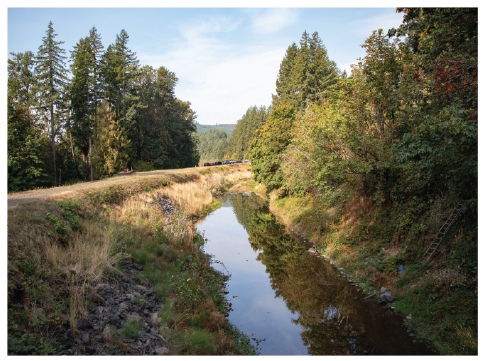
Get Leaburg Canal Updates
Services the Leaburg Hydroelectric Project Provides
The Leaburg Canal serves our community in many ways. Its key functions are:
- Power Generation – in optimal conditions, the 5-mile-long Leaburg Canal transports up to 2,500cfs of water diverted from the McKenzie River at the Leaburg Dam to drop into the Leaburg Powerhouse and can provide up to 15.9MW of electricity to EWEB customers, representing about 4% of EWEB’s electricity demand.
- Storm Water Conveyance (SWC) – The canal intercepts multiple creeks on the north side of the McKenzie Valley that used to be direct tributaries of the McKenzie River. Since the canal was built in the 1920's, those creeks became tributaries of the Leaburg Canal, and the canal carries their waters to the McKenzie as part of its “drop” into the Leaburg Powerhouse. This important role helps prevent flooding during storms and keeps the watershed connected. Commissioners may decide to repair the canal to preserve this current function, or the TBL Assessment may suggest solutions that include decommissioning parts of the canal and restoring these tributaries’ historic hydrologic pathways.
- Irrigation – The community of Leaburg has grown up around the canal in the last 100 years, including many farms and properties that draw water from the canal. Since de-watering the canal in October 2018, EWEB has worked with farmers to build check-dams in the canal so they are able to continue to draw water. EWEB staff will continue to communicate with the canal’s irrigators as we consider long-term solutions.
- Fish Hatcheries – The Leaburg Project serves as an unofficial demarcation between the lower and upper portions of the McKenzie River. Both the McKenzie Hatchery and the Leaburg Hatchery get their water from the Leaburg Canal. Both hatcheries would need to procure alternate water supplies should a decision affect the operation of the Leaburg Lake and the canal.
- Recreation – People from across Oregon visit Leaburg Lake to fish, boat, or picnic at Lloyd Knox Park. The Leaburg Canal is also a walking trail for people to hike, walk their dogs, or go birding. EWEB Commissioners will consider the community’s recreation opportunities when deciding the future of the canal.
- Transportation – The Leaburg Dam is also a bridge that connects the Leaburg Hatchery and a number of properties to Highway 126.
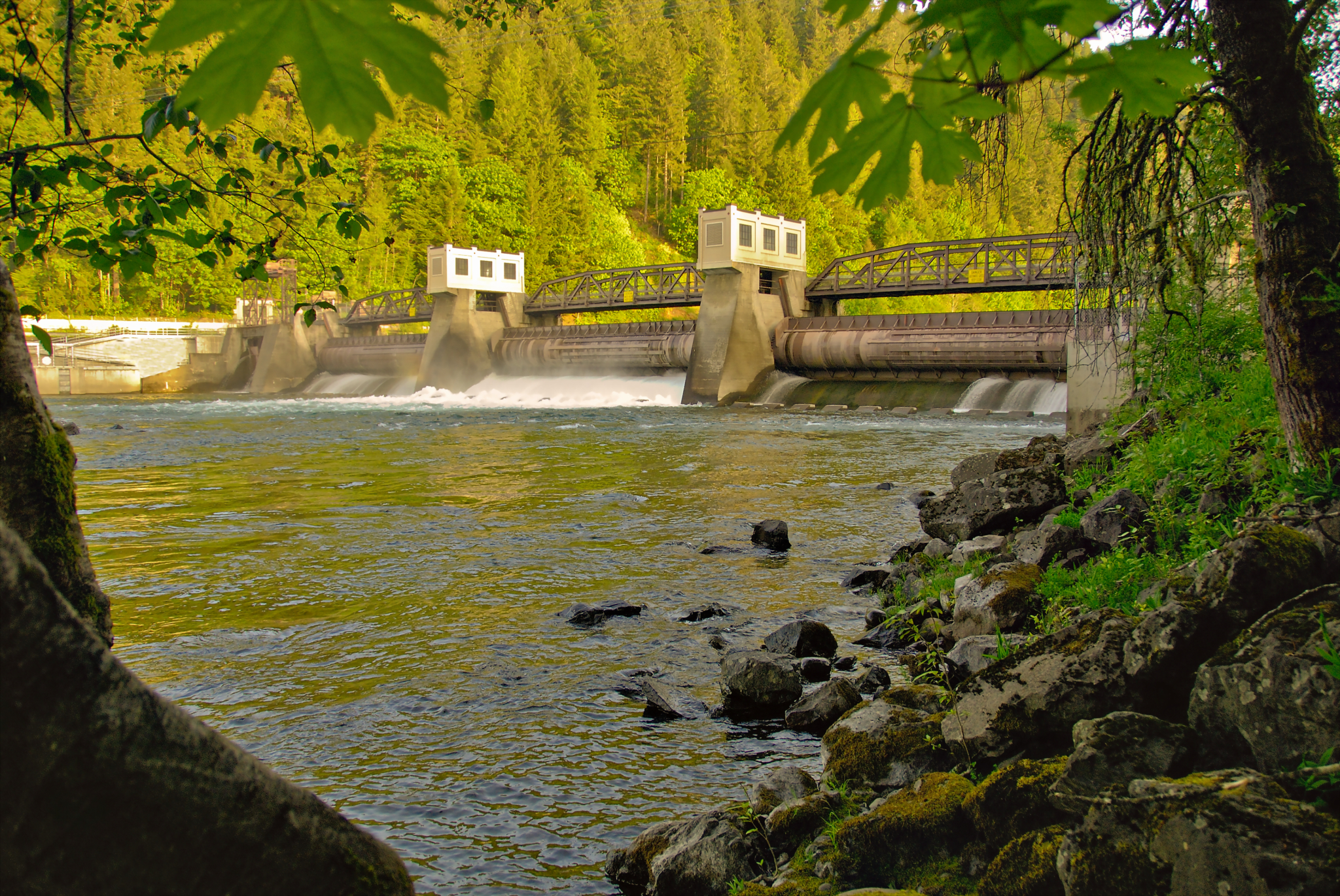
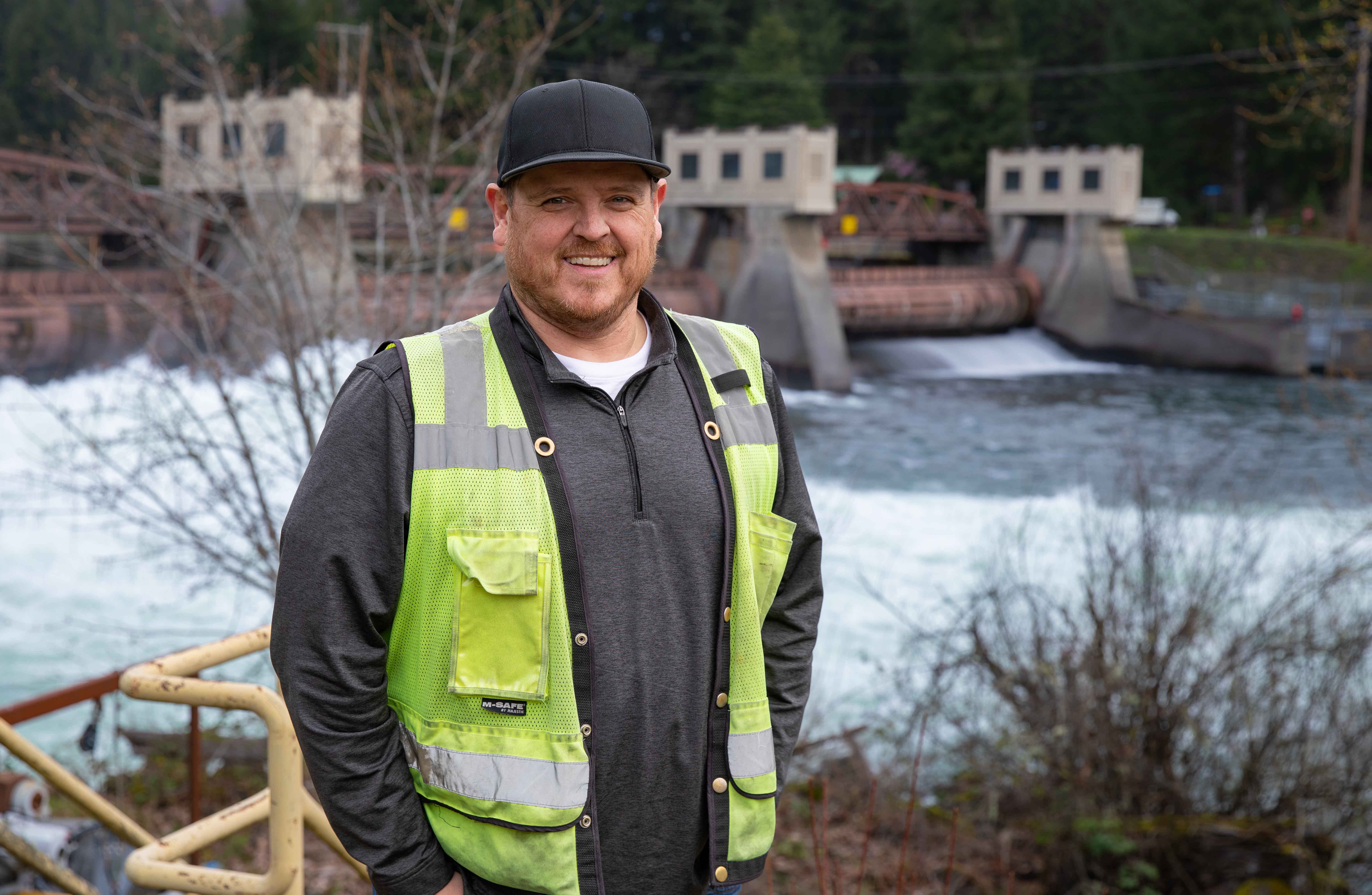
Meet the Leaburg Hydroelectric Project Team
- Generation Manager: Lisa Krentz
- Generation Engineering Supervisor: Mark Zinniker
- Leaburg Canal Strategic Evaluation Project Manager: Jeremy Somogye
- Communications Specialist: Adam Spencer
- Financial Analyst Alicia Voorhees
- Power Planning Supervisor Ben Ulrich
- Power Trader John Hart
- Chief Dam Safety Engineer: Laura Ohman
- Hydro Generation Supervisor: Chris Taylor (pictured)
- Generation Contract Supervisor: Patty Boyle
- Compliance Specialist Robin Leighty
- Environmental Specialist Andrew Janos
History of the Leaburg Hydroelectric Project
The Leaburg Project was built in the 1920s, with the completion of Leaburg Dam in 1929 creating the Leaburg Lake.
The lake still offers fishing, boating and picnicking today. EWEB's Lloyd Knox Park located along the shores of Leaburg Lake, 20 miles east of Springfield offers recreational opportunities for people of all interests — and it's free.
The Leaburg Power Plant was designed in 1929 by noted Oregon architect Ellis F. Lawrence in the Art Deco style and includes motifs from Greek mythology. According to the University of Oregon's Oregon Digital Library, "The powerhouse is the finest example of Art Deco architecture used in an industrial setting in Oregon."
The Leaburg development is the Project's upstream facility and includes a dam, canal, forebay, penstocks, powerhouse, tailrace, and substation. Leaburg Dam is a reinforced concrete and steel structure that impounds run-of-the river flows on the McKenzie River. The dam was constructed in the 1920’s to divert water into the Leaburg Canal where it is used to produce power approximately 4.5 miles downstream.
The dam is approximately 400-feet long and 22 feet high. It has three 100-foot-long by 9-foot high roll gates that control the reservoir level and allow passage of flood flows over the dam. Leaburg Dam is also equipped with a sluiceway, left- and right-bank fish ladders, and intake gates that divert the water from the McKenzie River. During extreme flows, the canal headgates are closed, and all of the river flow passes over the dam. A 14-foot-wide single-lane bridge, located on top of the dam, provides access to the Leaburg Fish Hatchery, Lloyd Knox Park, and several private residences on the river's left bank.
Leaburg Lake is a 57 acre, 345 acre-foot backwater formed by Leaburg Dam and extends about 1.5 miles upstream. Rollgate hoists automatically modulate to maintain Leaburg Lake's water surface at 742.5 feet. During high flow, the gates can be opened to pass inflows of up to 90,000 cfs without overtopping the dam.
Up to 2,500cfs of water diverted at the Leaburg Dam for power generation passes through a downstream migrant fish screening system and enters the 5-mile-long, 15-foot-deep, cut-and-fill unlined Leaburg Canal leading to the power plant forebay. The fish screening system and a trash rack prevent fish and debris from entering the canal. The forebay includes a penstock intake, automatic siphon bypass spillway, trash rack, and ice-trash sluiceway.
From the forebay, water flows into the Leaburg Plant through two reinforced concrete pipe penstocks 12 feet in diameter and 260 feet long, which creates a maximum hydraulic head of 89 feet. The Leaburg Plant contains two Francis turbines connected to generating units with nameplate ratings of 8.4 MW (Unit 1) and 7.5 MW (Unit 2). The total installed capacity at the Leaburg powerhouse is 15.9 MW. Water is returned to the McKenzie River from the Leaburg Plant through a 1,100-foot-long tailrace. An automatic siphon spillway bypasses canal flows to protect the canal, forebay, and powerhouse in case of an emergency turbine shutdown.
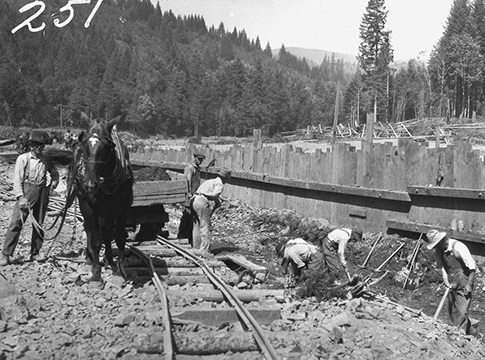
Related Programs
Managing peak electricity demand is a critical component of achieving climate recovery goals and keeping energy affordable for all customers.
As a public utility, we share our customers' values around environmental stewardship.
Here are some of the ways we work proactively to keep the lights on and the tap water flowing.





